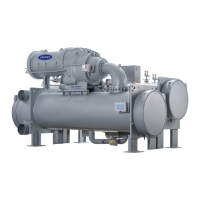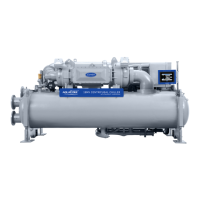67
the SETUP1 table. The compressor will restart when the chiller
is:
• in LCW CONTROL and the LEAVING CHILLED
WATER temperature is greater than the CONTROL
POINT plus the RECYCLE RESTART DELTA T.
•in ECW CONTROL and the ENTERING CHILLED
WATER temperature is greater than the CONTROL
POINT plus the RECYCLE RESTART DELTA T.
Once these conditions are met, the compressor initiates a
start-up with a normal start-up sequence.
An alert condition may be generated if 5 or more recycle
start-ups occur in less than 4 hours. Excessive recycling can
reduce chiller life; therefore, compressor recycling due to ex-
tremely low loads should be reduced.
To reduce compressor recycling, use the time schedule to
shut the chiller down during known low load operation period,
or increase the chiller load by running the fan systems. If the
hot gas bypass is installed, adjust the values to ensure that hot
gas is energized during light load conditions. Increase the
RECYCLE RESTART DELTA T on the SETUP1 table to
lengthen the time between restarts.
The chiller should not be operated below design minimum
load without a hot gas bypass installed.
Safety Shutdown — A safety shutdown is identical to
a manual shutdown with the exception that, during a safety
shutdown, the ICVC displays the reason for the shutdown, the
alarm light blinks continuously, and the spare alarm contacts
are energized.
After a safety shutdown, the softkey must be
pressed to clear the alarm. If the alarm condition is still present,
the alarm light continues to blink. Once the alarm is cleared,
the operator must press the or softkeys to re-
start the chiller.
BEFORE INITIAL START-UP
Job Data Required
• list of applicable design temperatures and pressures
(product data submittal)
• chiller certified prints
• starting equipment details and wiring diagrams
• diagrams and instructions for special controls or options
• 19XR Installation Instructions
Equipment Required
• mechanic’s tools (refrigeration)
• digital volt-ohmmeter (DVM)
• true RMS digital multimeter with clamp-on current
probe or true RMS digital clamp-on ammeter for at least
480 vac or 700 vdc (19XRV only).
• electronic leak detector
• absolute pressure manometer or wet-bulb vacuum
indicator (see Fig. 32)
• 500-v insulation tester (megohmmeter) for compressor
motors with nameplate voltage of 600 v or less, or a
5000-v insulation tester for compressor motor rated
above 600 v
Using the Optional Storage Tank and Pum-
pout System —
Refer to Positive Pressure Chillers with
Storage Tanks section, page 90 for pumpout system prepara-
tion, refrigerant transfer, and chiller evacuation.
Remove Shipping Packaging — Remove any pack-
aging material from the control center, power panel, guide vane
actuator, motor cooling and oil reclaim solenoids, motor and
bearing temperature sensor covers, and the factory-mounted
starter.
Open Oil Circuit Valves — Check to ensure the oil fil-
ter isolation valves (Fig. 6 and 7) are open by removing the
valve cap and checking the valve stem.
Tighten All Gasketed Joints and Guide Vane
Shaft Packing — Gaskets and packing normally relax
by the time the chiller arrives at the jobsite. Tighten all gasket-
ed joints and the guide vane shaft packing to ensure a leak-tight
chiller. Gasketed joints (excluding O-rings) may include joints
at some or all of the following:
• Waterbox covers
• Compressor suction elbow flanges (at compressor and at the
cooler)
• Compressor discharge flange
• Compressor discharge line spacer (both sides) if no isolation
valve
• Cooler inlet line spacer (both sides) if no isolation valve
• Hot gas bypass valve (both sides of valve)
• Hot gas bypass flange at compressor
Refer to Table 10 for bolt torque requirements.
Check Chiller Tightness — Figure 33 outlines the
proper sequence and procedures for leak testing.
The 19XR chillers are shipped with the refrigerant con-
tained in the condenser shell and the oil charge in the compres-
sor. The cooler is shipped with a 15 psig (103 kPa) refrigerant
charge. Units may be ordered with the refrigerant shipped sepa-
rately, along with a 15 psig (103 kPa) nitrogen-holding charge
in each vessel.
To determine if there are any leaks, the chiller should be
charged with refrigerant. Use an electronic leak detector to
check all flanges and solder joints after the chiller is pressur-
ized. If any leaks are detected, follow the leak test procedure.
If the chiller is spring isolated, keep all springs blocked in
both directions to prevent possible piping stress and damage
during the transfer of refrigerant from vessel to vessel during
the leak test process, or any time refrigerant is being trans-
ferred. Adjust the springs when the refrigerant is in operating
condition and the water circuits are full.
Refrigerant Tracer — Carrier recommends the use of an
environmentally acceptable refrigerant tracer for leak testing
with an electronic detector.
Ultrasonic leak detectors can also be used if the chiller is
under pressure.
Fig. 32 — Typical Wet-Bulb Type
Vacuum Indicator

